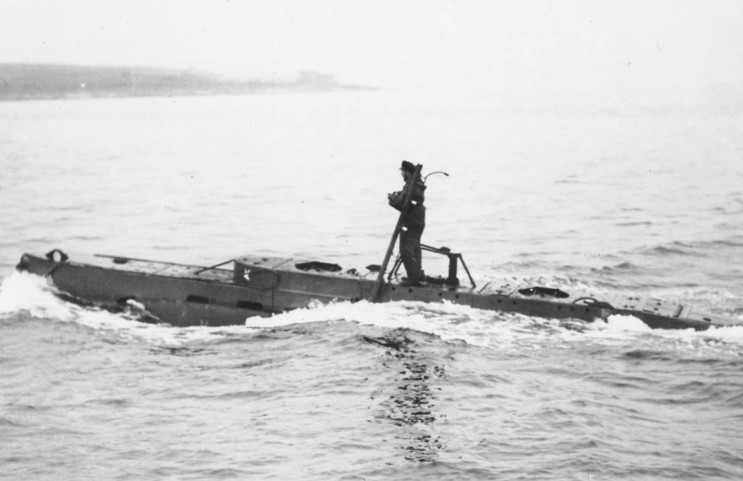|
In May of 1941 the German battleship Bismarck was hunted down and sunk by the Royal Navy, however the cost was very heavy, the battlecruiser HMS Hood was sunk and all but three of her over 1,400 crew were killed. Even with the superiority of the British Fleet, the ever looming threat of the Bismarck's sister Tirpitz weighed heavy on the Admiralty. Under almost constant attack starting in July 1940, before she was even complete, the Tirpitz remained the greatest threat the British saw to the convoy system. Between May 1941 and Sept. 1943 there were seven attacks or attempts to sink the Tirpitz, all but one was made with aircraft. The enormous effort put forth by the British did not produce a pay off, very little damage had been done to the ship and several aircraft and crews were lost trying, it was time for a different strategy. In September the Royal Navy would make an attempt to sink not only Tirpitz, but Scharnhorst and Lützow as well in one coordinated attack, not with battleships, but with 27 ton four man submarines called X-Craft's. Looking back more than sixty years later one can hardly imagine that the British thought they could destroy the most powerful battleship in the world with a tiny little submarine, and the thought of sinking three heavy warships at the same time could be viewed as preposterous, but it was the decision that was made and as the Royal Air Force had no success in sinking them the times called for desperate measures. On paper the mission sounds simple, six submarines would tow the X-Craft to the target area, the X-Craft would then slip into the fjord, stop under the target, release two 2 ton explosive charges and then return to the waiting submarine and be towed home. If you add in a few details the mission becomes a little more complicated. Kåfjord in Norway is over 1,100 statute miles, in a straight line, from northern Scotland, towing six submarines to the northern tip of Norway would be no small feat. And of course it goes without saying they would need to be unseen by any German ship, submarine or aircraft, and they would have to survive the weather. After arriving at the entrance to the fjord, the X-Craft would be released and would have to enter the fjord and pass the German defenses undetected. This would include mines, anti-submarine nets and of course patrol craft and shore patrols. They would then have to approach some of the most powerful warships in the world, again without being seen, get directly under the unseen target and release the 2 ton charges which were attached to the outside of the hull and leave the fjord before the charges went off. Before the attack could be made two of the craft were lost, X-9 sank en route on Sept. 16 while under tow by HMS Syrtis P-241 with all hands (apparently the C.O. M. H. Jupp was not on board when the X-9 sank). X-8 developed a mechanical defect and was scuttled on Sept. 18, her mission was to attack Lützow in Langefjord. All but the above mentioned made it to the Altafjord and on Sept. 22, 1943 launched the attack. The target for X-10 (and X-9) was the battleship Scharnhorst, however she was not in the fjord and X-10 abandoned the mission. She had also developed a mechanical fault and had navigation trouble, she was recovered by HMS Stubborn P-238 five days later and was the only X-Craft to survive the mission. X-5, X-6 and X-7 proceeded to attack the Tirpitz, however X-5 sank for unknown reasons and has not been found to this day. Charges believed to have belonged to her have been located not far from where the Tirpitz was anchored, and the crew of the Tirpitz claimed firing the 105mm gun and hitting a submerged target, but the final resting place of the X-5 and her crew is still a mystery. X-6 and X-7 actually managed to drop their charges under the Tirpitz, but both X-Craft had to be scuttled after broaching the surface and coming under fire from Tirpitz. Six men from the two craft were taken prisoner, but two were killed. Those who survived were being interrogated by the Germans on the Tirpitz, saying nothing about what was going to happen, when the charges exploded. They could have been killed by the explosions or have drowned if the ship went down, but fortunately for them they were for the most part uninjured. One crewman on Tirpitz was killed and finally the German battleship had been seriously damaged. The hull was damaged along with the turbines, rudder and propeller shafts, she was out of action until April of the following year. They had not managed to sink her, but these brave men proved such a mission could be done. Their heroism was recognized by the Crown with Victoria Crosses for the commanders of X-6 and X-7 and awards for the rest. |
Roll of Honour |
In memory of those who lost their lives in HMS X-9, HMS X-5 and HMS X-7 "As long as we embrace them in our memory, their spirit will always be with us" |
Name |
Rate |
Boat |
|
Harte, Harry A. |
Able Seaman |
X-9 |
|
Henty-Creer, Henty |
Lieutenant (RNVR) |
X-5 |
|
Hollett, George H. |
Stoker 1st Class |
X-9 |
|
Kearon, Edward |
Sub-Lieutenant (RNVR) |
X-9 |
|
Malcolm, Alastair D. |
Sub-Lieutenant (RNVR) |
X-5 |
|
Mortiboys, Ralph J. |
Engine Room Artificer 4th Class |
X-5 |
|
Nelson, Tom J. |
Sub-Lieutenant (RNVR) |
X-5 |
|
Whitley, William M. |
Engine Room Artificer 4th Class |
X-7 |
|
Whittam, Lionel B. |
Lieutenant (RNVR) |
X-7 |
© 2008 Michael W. Pocock MaritimeQuest.com |
 |
HMS X-5 on trials.
|
2006 Daily Event |
||